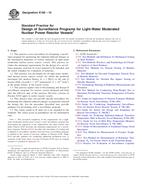Potřebujeme váš souhlas k využití jednotlivých dat, aby se vám mimo jiné mohly ukazovat informace týkající se vašich zájmů. Souhlas udělíte kliknutím na tlačítko „OK“.
ASTM E185-10
Standard Practice for Design of Surveillance Programs for Light-Water Moderated Nuclear Power Reactor Vessels
Automaticky přeložený název:
Standardní praxe pro návrh programy dozoru nad Light-Water Moderuje Nuclear Power reaktorů
NORMA vydána dne 1.3.2010
Informace o normě:
Označení normy: ASTM E185-10
Poznámka: NEPLATNÁ
Datum vydání normy: 1.3.2010
Kód zboží: NS-43304
Počet stran: 8
Přibližná hmotnost: 24 g (0.05 liber)
Země: Americká technická norma
Kategorie: Technické normy ASTM
Anotace textu normy ASTM E185-10 :
Keywords:
Nuclear applications/materials--steel, Nuclear reactor vessels--light-water cooled, Nuclear reactor vessels--surveillance, Radiation exposure--nuclear materials/applications, Repair by welding (for steel for nuclear/special applications), Steel screens, ICS Number Code 27.120.10 (Reactor engineering)
Doplňující informace
| Significance and Use | ||||||||||||||||||||||||||||||||||||||||||
|
Predictions of neutron radiation effects on pressure vessel steels are considered in the design of light-water moderated nuclear power reactors. Changes in system operating parameters often are made throughout the service life of the reactor vessel to account for radiation effects. Due to the variability in the behavior of reactor vessel steels, a surveillance program is warranted to monitor changes in the properties of actual vessel materials caused by long-term exposure to the neutron radiation and temperature environment of the reactor vessel. This practice describes the criteria that should be considered in planning and implementing surveillance test programs and points out precautions that should be taken to ensure that: (1) capsule exposures can be related to beltline exposures, (2) materials selected for the surveillance program are samples of those materials most likely to limit the operation of the reactor vessel, and (3) the test specimen types are appropriate for the evaluation of radiation effects on the reactor vessel. The methodology to be used in estimation of neutron exposure obtained for reactor vessel surveillance programs is defined in Guide E482. The design of a surveillance program for a given reactor vessel must consider the existing body of data on similar materials in addition to the specific materials used for that reactor vessel. The amount of such data and the similarity of exposure conditions and material characteristics will determine their applicability for predicting radiation effects. |
||||||||||||||||||||||||||||||||||||||||||
| 1. Scope | ||||||||||||||||||||||||||||||||||||||||||
|
1.1 This practice covers procedures for designing a surveillance program for monitoring the radiation-induced changes in the mechanical properties of ferritic materials in light-water moderated nuclear power reactor vessels. This practice includes the minimum requirements for the design of a surveillance program, selection of vessel material to be included, and the initial schedule for evaluation of materials. 1.2 This practice was developed for all light-water moderated nuclear power reactor vessels for which the predicted maximum fast neutron fluence (E > 1 MeV) at the end of license (EOL) exceeds 1 × 1021 neutrons/m2 (1 × 1017 n/cm2) at the inside surface of the reactor vessel. 1.3 This practice applies only to the planning and design of surveillance programs for reactor vessels designed and built after the effective date of this practice. Previous versions of Practice E185 apply to earlier reactor vessels. 1.4 This practice does not provide specific procedures for monitoring the radiation induced changes in properties beyond the design life, but the procedure described may provide guidance for developing such a surveillance program. 1.5 The values stated in SI units are to be regarded as the standard. The values given in parentheses are for information only. Note 1—The increased complexity of the requirements for a light-water moderated nuclear power reactor vessel surveillance program has necessitated the separation of the requirements into three related standards. Practice E185 describes the minimum requirements for a surveillance program. Practice E2215 describes the procedures for testing and evaluation of surveillance capsules removed from a surveillance program as defined in the current or previous editions of Practice E185. Guide E636 provides guidance for conducting additional mechanical tests. A summary of the many major revisions to Practice E185 since its original issuance is contained in Appendix X1. |
||||||||||||||||||||||||||||||||||||||||||
| 2. Referenced Documents | ||||||||||||||||||||||||||||||||||||||||||
|




 Cookies
Cookies
